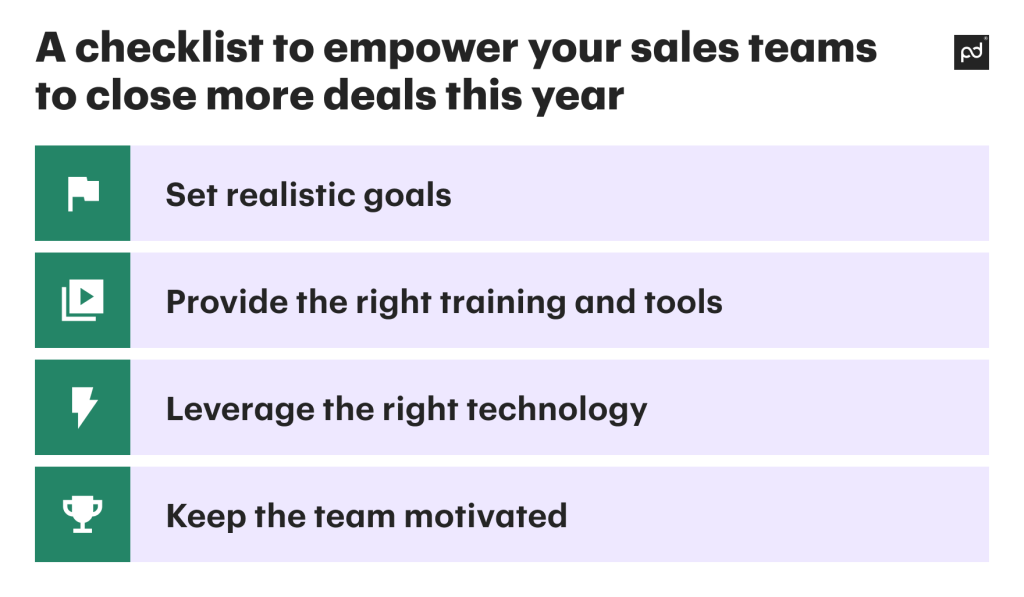New Year. New goals. Hopefully, the start of the new year has you super jazzed about what your sales organization will achieve in 2024. We know we’re excited about the potential our sales team has at PandaDoc.
A sales team is the powerhouse behind any thriving software company. Your team’s role is absolutely critical in achieving business goals and facilitating growth.
But things can get a little mundane and stale between identifying new opportunities, generating leads, and converting those leads into customers. Every once in a while, it’s nice to ask for help to gain a fresh perspective.
So, we’ve rounded up this nice little checklist for you to empower your sales team to step outside the norm, get uncomfortable, and then obliterate their sales goals this year.
Item 1: Set realistic goals
First and foremost, setting clear, realistic goals is crucial for your sales team. It sounds simple enough, right? But here’s the thing – setting realistic goals can really make or break your sales team’s morale and motivation in the long run.
Think about it. If you set a goal that’s way out of reach, it can be demotivating. Your team might feel like they’re trying to climb a mountain that just keeps getting steeper. By setting achievable quotas, you can bring more positivity and motivation to your team. Seeing the finish line at the end of a race gives you that extra push to keep going.
Achievable quotas also encourage healthy competition within the team. When everyone’s working towards a realistic target, they can see where they stand and how much further they need to go. It’s a great way to keep everyone on their toes and striving for success.
Now, let’s talk incentives. They’re like the cherry on top of the goal-setting cake. Incentives, or spiffs, can really boost motivation. They can give your team that extra motivation they need to work towards and make achieving those sales targets even more rewarding.
But here’s the key – structure your incentives to make your goals more realistic and achievable. For example, you could offer a cash bonus or gift card of their choice for every deal closed above a certain threshold. This way, your team has a clear, reachable target and an added incentive to exceed it.

Item 2: Provide the right training and tools
In today’s rapidly evolving market, providing continuous training is crucial – and it’s not just for the sake of staying ahead of the curve. This investment can have a positive impact on your bottom line, too.
Think about it. When you invest in training programs tailored to your sales team’s specific needs and learning styles, you’re not just helping them improve their skills. You’re also boosting their confidence and motivation. It’s like giving them the map and compass to navigate the sales jungle successfully.
Now, let’s talk about technology. It’s no secret that tech has revolutionized the sales process. From CRM tools that help manage customer relationships to computer-assisted proposal software that streamlines the creation of sales proposals, your team needs to be up on the latest and greatest.
Imagine your team using a virtual product demonstration tool to show off your latest software to a potential client halfway across the world. Not only does this save time and resources, but it also gives your team the flexibility to cater to clients in various locations.
And let’s remember data analysis. With advanced sales management tools, your team can track and analyze sales performance in real-time. They can identify trends, spot opportunities, and make data-driven decisions. It’s like having a personal coach guiding them towards their sales goals.
When you, as a sales leader, make the right investments in continuous training and leveraging the power of technology, your team – and your bottom line – will thank you for it!
Item 3: Leveraging the right technology
You know as well as I do that technology’s been a game-changer in the sales world. We’ve gone from a family station wagon, clunky and slow, to a Maserati, fast and streamlined.
Let’s talk about lead generation first. Remember the days when we had to search for potential customers manually? Well, those days are long gone. With tech tools, we can now identify potential leads at the click of a button. And it doesn’t stop there. We can also engage with these leads meaningfully and personally, making sales outreach more effective.
And how about sales analytics and forecasting? Gone are the days of guesswork and gut feelings. With advanced analytics, we can now make data-driven decisions and accurate forecasts. It’s like having a crystal ball that shows us the future of our sales.
Then there’s your CRM. These are like our personal assistants, helping us track customer interactions, manage our sales pipelines, and automate routine tasks. Integrating a CRM into your sales process can work wonders for lead generation and pipeline management. It’s like having an extra pair of hands.
But wait, there’s more. Other sales automation tools, like proposal software, can complement your CRM beautifully. Imagine creating a detailed, personalized, on-brand sales proposal with auto-populated customer data in minutes instead of hours. Sounds good, right?
Technology has provided sales leaders like you with so many benefits that it’s impossible not to embrace technology and scale your sales efforts. By making these tech investments, it’s almost guaranteed that you’ll see a massive boost in productivity that your team will thank you for. After all, who wouldn’t want to trade in their old station wagon for a Maserati?
Item 4: Keeping the team motivated
How do you keep motivation high, especially during those slower periods? Well, we’ve got a few ideas.
First, let’s talk about recognizing and rewarding top performers. You’ve got stars on your team who are smashing their targets, right? Don’t let that go unnoticed! Give them a shout-out in your next team meeting, on Slack, or better yet, surprise them with a reward. It doesn’t have to be grand – even a small token of appreciation can make a huge difference. And when the rest of your team sees that hard work gets rewarded, they’ll be inspired to step up their game, too.
Next, cultivate a positive sales culture. It’s essential to create a sense of community and shared purpose. How about organizing some team-building activities or outings? A day at an escape room, a friendly competition, or a virtual team lunch can work wonders. These activities strengthen the bonds within your team and ignite the team spirit that’s so crucial in sales.
Even during slower periods, it’s essential to maintain an effective sales strategy to meet those quarterly and annual sales quotas. Remember, a slow period isn’t a downtime – it’s an opportunity to refine your strategy and prepare for the next sales surge. So, keep that strategy sharp, and your team will stay focused and motivated.
Lastly, inspire creativity within your team. The market landscape constantly changes, and keeping up requires innovative sales strategies. Encourage your team to think outside the box or follow thought leaders on LinkedIn. Maybe they’ll be inspired with a new approach to pitching, or find a novel way to engage with customers. They’ll be more invested in their work when they feel their ideas are valued.
In summary
Sales can be a challenging and fast-paced industry. However, the right approach and mentality can also be incredibly rewarding. By setting clear goals, providing support and education to your team, maintaining an effective strategy, and encouraging creativity, you can lead your team to success. Remember to stay positive and motivated yourself – as a leader, your attitude sets the tone for your team’s performance. With these tips in mind, your sales team will undoubtedly reach new heights this year and make every sales period successful.
Thank you for reading this guide on empowering your sales team to close more deals. We hope it has provided valuable insights and actionable tips for your business. Keep pushing forward, and remember there is always room for growth and improvement, even during slow periods. Good luck!


